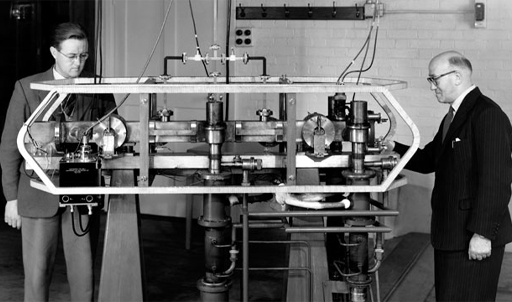2 How time is measured
Time cannot be discussed for long without an understanding of how it is measured. How long is one second? If there are 60 seconds in a minute, 60 minutes in an hour and 24 hours in a day, then a second could be defined as 1/86400 of a day. But then, how long is a day?
Traditionally that question was answered by astronomers. For many centuries they had the job of measuring the length of the day (strictly the ‘mean solar day’) by observing the apparent motions of the Sun and stars as the Earth rotated. But by the 20th century, it was becoming clear that that the rotation of the Earth was not completely smooth, and the length of the day was not constant. So what does that mean for the measurement of time?
A way forward appeared in the 1950s with the invention of the first practical atomic clocks. Rather than relying on pendulums or electronic oscillators – as the best clocks then did – atomic clocks count the vibrations of microwave radiation from atoms (in particular the caesium atom).
Figure 1 shows the world’s first practical atomic clock, built at the UK National Physical Laboratory under the leadership of Louis Essen, who had earlier made accurate measurements of the speed of light. It is now at the Science Museum in London.
With these clocks, physicists soon discovered that ‘atomic time’ is far more stable than time kept by the rotating Earth, or even the best conventional clocks. What is known as International Atomic Time (or TAI, from the French Temps atomique international) officially began on 1 January 1958 and has been running steadily ever since.
In 1967, the second was redefined as the duration of 9 192 631 770 periods of the radiation from the caesium atom. The definition, part of the International System of Units (or SI, from Système international), was chosen to match the duration of the astronomical second as measured by atomic clocks in 1958. Since 1972, a time scale derived from TAI, known as Coordinated Universal Time (UTC), has become the basis for all civil and scientific timekeeping. UTC attempts to keep in step with the rotation of the Earth by introducing an occasional ‘leap’ second. At time of writing in 2022, UTC is 37 seconds behind TAI.
But there is no one atomic ‘master clock’. TAI is actually the average of more than 450 atomic clocks maintained by laboratories around the world, with the duration of the second determined by about a dozen ultra-precise machines designated as primary frequency standards. TAI is occasionally ‘steered’ to ensure that the length of the second remains as close to the formal definition as it possibly can. The best atomic clocks will gain or lose no more than a second in 100 million years.
So, what is time? A pragmatic definition is that time is what is measured by clocks – and the most accurate time is TAI, measured by atomic clocks.

